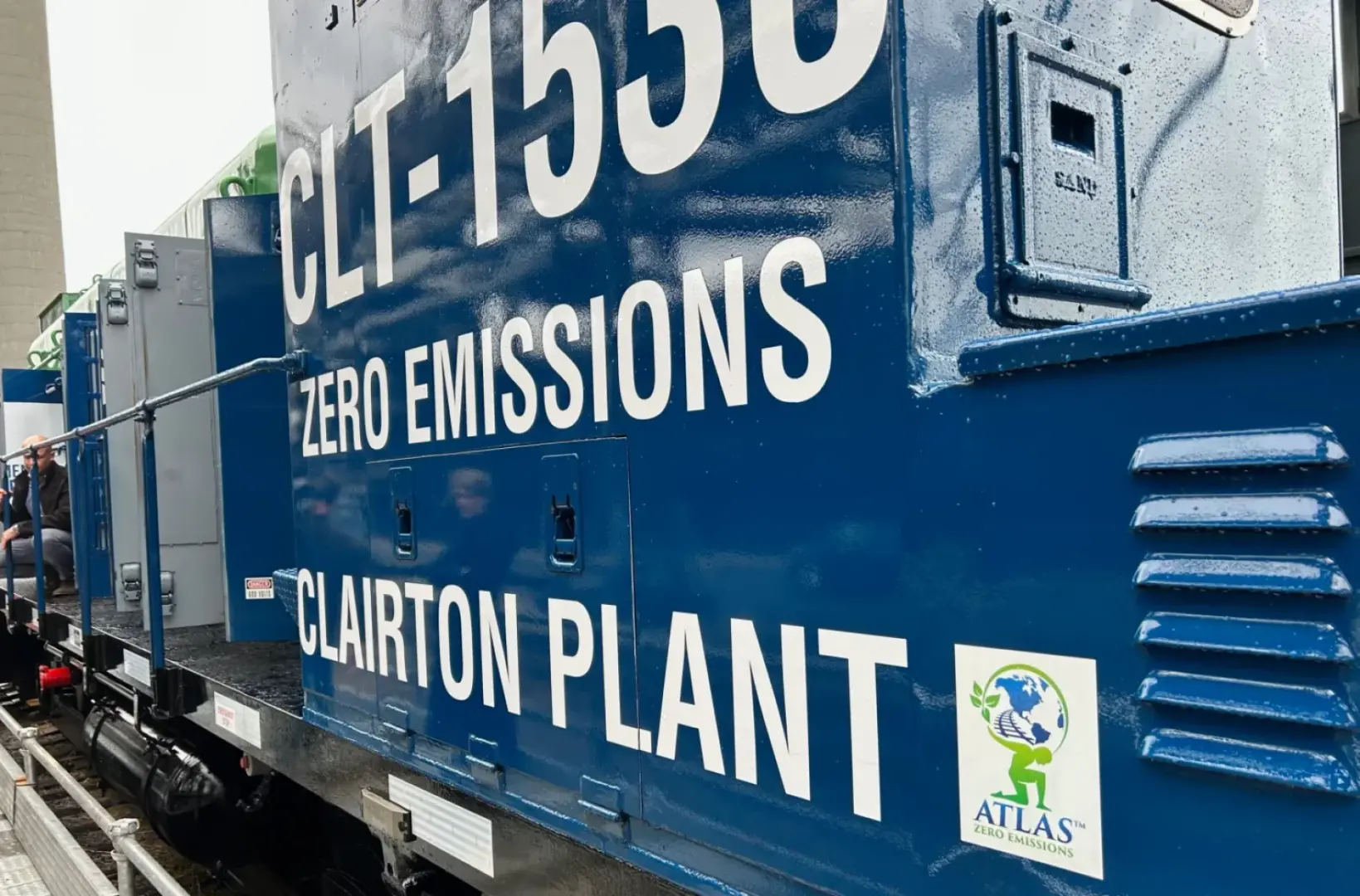
The two new electric locomotives will save 40,000 gallons of diesel fuel a year and emit no CO2.
Reid Frazier / The Allegheny Front


The two new electric locomotives will save 40,000 gallons of diesel fuel a year and emit no CO2.
Reid Frazier / The Allegheny Front

Reid Frazier / The Allegheny Front
The two new electric locomotives will save 40,000 gallons of diesel fuel a year and emit no CO2.
U.S. Steel unveiled a new battery-powered locomotive for its Clairton Coke Works near Pittsburgh on Monday. The company is switching two of the 10 locomotives it uses in its local operations to electric from diesel-powered.
Most of the money for the project — about $4.5 million — comes from the Pennsylvania Department of Environmental Protection grant program funded by its portion of the 2017 Volkswagen settlement, which the carmaker paid for installing software on diesel vehicles to cheat federal air emissions tests.
U.S. Steel paid $2.3 million toward the project, the company said. Unlike the diesel locomotives they will replace, the battery-operated units will emit no carbon dioxide or particulate matter.
U.S. Steel CEO David Burritt said at an unveiling ceremony at Clairton that the battery-powered trains would be the first of their kind in North America.
“At U.S. Steel, our mission is profitable steel solutions for people and our most important customer: the planet,” Burritt said. “And when you have reduced emissions, reduced fuel consumption, and also even reduced sound with this innovative technology, it really says volumes about what we’re doing as a company.”
The new locomotives will be used to haul iron ore, coke and steel at Clairton and Edgar Thomson Works in Braddock, and will save 40 thousand gallons of diesel fuel a year.
The company said the new locomotives would prevent a little more than a third of a ton of particulate matter a year from the facilities, the equivalent of 7,000 cars on the road.
These emissions reductions represent a tiny fraction of the company’s local pollution footprint. According to the U.S. EPA, the company emits close to 4 million metric tons of carbon dioxide a year in the Mon Valley, making it one of the top greenhouse gas emitters in the state. The 40,000 gallons of diesel that the locomotives would save represent just 400 metric tons of CO2.
U.S. Steel is far and away the largest single source of particulate pollution in Allegheny County. It emits over 350 tonsof particle pollution a year, according to state data. The EPA recently ordered Allegheny County to rewrite its pollution permit for the Clairton plant.
DEP spokesperson Lauren Camarda said in an email the grant to U.S Steel was the largest ever given from the Diesel-gate money.
“DEP supports the project and applauds U.S. Steel for its commitment to replacing diesel locomotives built in 1964 and 1974 with state-of-the-art battery electric locomotives ahead of schedule,” Camarda said.
“Reducing diesel emissions in and around ports, intermodal facilities, railyards, and distribution centers is one of the top priorities” for the grant program, Camarda said, “as these types of facilities emit large quantities of harmful air pollution, and many are co-located alongside environmental justice areas, some of the most disproportionately impacted communities in Pennsylvania.”
Clairton and Braddock are two environmental justice areas, as designated by the state.
Mike Nicoletti of Innovative Rail Technologies, which built the locomotives, said the technology is still in its infancy, and U.S. Steel’s sprawling steel facilities were an ideal setting for such a new technology.
“For U.S. Steel, you have a dedicated captive fleet of locomotives that serves locally, and that gives you a more predictable charging schedule, more predictable routing. That’s kind of the advantage where you get into pure electrification,” Nicoletti said.
Battery-powered rail may be far away from long-haul rail, but for short trips, it is feasible, Nicoletti said. The two locomotives would use lithium-ion batteries to power 1,300 horsepower engines.
“The technology first has to take root here at places like U.S. Steel that want to embrace the technology,” Nicoletti said. “If you look at the industry historically, all the major technological changes happen in the yard in the industrial settings before it migrated into the (long) haul service. So this is actually an ideal logical place to start in.”
StateImpact Pennsylvania is a collaboration among WITF, WHYY, and the Allegheny Front. Reporters Reid Frazier, Rachel McDevitt and Susan Phillips cover the commonwealth’s energy economy. Read their reports on this site, and hear them on public radio stations across Pennsylvania.
(listed by story count)
StateImpact Pennsylvania is a collaboration among WITF, WHYY, and the Allegheny Front. Reporters Reid Frazier, Rachel McDevitt and Susan Phillips cover the commonwealth’s energy economy. Read their reports on this site, and hear them on public radio stations across Pennsylvania.
Climate Solutions, a collaboration of news organizations, educational institutions and a theater company, uses engagement, education and storytelling to help central Pennsylvanians toward climate change literacy, resilience and adaptation. Our work will amplify how people are finding solutions to the challenges presented by a warming world.